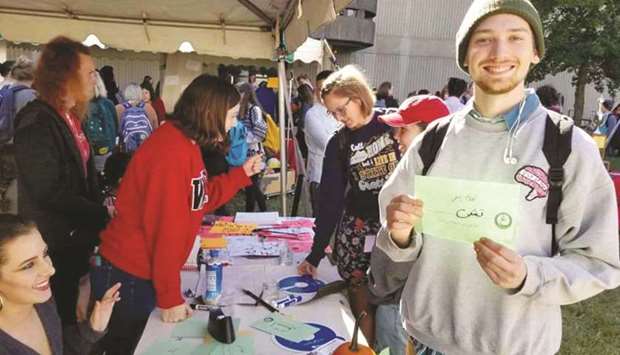Qatar Foundation International (QFI) has launched the German version of Q-Wheel, also known as the Wheel of Letters, or Madar Al-Huruf, an ideal starting point for new Arabic language learners.
Launched almost 10 years ago, the rotatable disc matches Arabic letters and their sounds to similar-sounding letters and combinations in English and now in German. It’s been ideal for new learners to begin learning by spelling their own names in Arabic. And it is available as a physical wheel and also as a mobile app.
The Q-Wheel story began when Muneera al-Badi was living in the United States with her family and wanted to put her degree from Virginia Commonwealth University School of the Arts in Qatar to good use and she came across QFI.
“I really connected with their mission to bring the Arabic language into classrooms to reach young learners,” she said. “I knew that there had to be a way to demystify the Arabic characters and connect them to the English language phonetically.”
Once she had come up with the concept of the rotatable wheel, al-Badi liaised closely with teachers to make the content as clear and usable as possible. The wheel was then publicly introduced in June 2012 in Rio de Janeiro at the Qatari Pavilion during the Rio+20 UN Conference on Sustainable Development.
The Q-Wheel went on to be featured at all QFI’s events and celebrations. The wheel has a wide range of potential applications beyond transliterating. Arabic language teachers have used it as a recruiting tool when students are choosing which foreign language to study.
“I always start the school year with the Q-Wheel – it’s a wonderful starting point for non-native Arabic speakers,” says Nour Jandali, chair, Global World Languages and IB Arabic teacher at Cholla High School in Tucson, Arizona.
Jandali underlines that placing the Q-Wheel in students’ hands and giving them the opportunity to write their names in Arabic with absolutely no prior experience or knowledge of the language, helps bridge the gap between students and the love of learning Arabic.
The Q-Wheel has been widely used in art classes for calligraphy and has also been utilised as a means of introducing Arabic cultural elements in classes including social studies and history.
Throughout the Q-Wheel’s path, QFI has covered the costs of producing and printing the physical wheels and accompanying workbooks and supported its development and distribution, bringing it to tens of thousands of teachers, students, conference attendees and others all over the world.
Having seen the success of the wheel, QFI realised that to provide truly global access, it needed to go digital. First, it teamed up with QF member Hamad Bin Khalifa University’s Qatar Computing Research Institute to launch an initial beta mobile app of the wheel. Next, QFI brought in Mindgrub, an award-winning app-development team, to update and redesign the mobile app, which now includes sounds, so beginners are able to hear, not just see, the Arabic alphabet. In 2016, the app won a World Summit Award within the WSA-mobile category.
The Q-Wheel story began when Muneera al-Badi was living in the United States with her family and wanted to put her degree from Virginia Commonwealth University School of the Arts in Qatar to good use and she came across QFI.
“I really connected with their mission to bring the Arabic language into classrooms to reach young learners,” she said. “I knew that there had to be a way to demystify the Arabic characters and connect them to the English language phonetically.”
Once she had come up with the concept of the rotatable wheel, al-Badi liaised closely with teachers to make the content as clear and usable as possible. The wheel was then publicly introduced in June 2012 in Rio de Janeiro at the Qatari Pavilion during the Rio+20 UN Conference on Sustainable Development.
The Q-Wheel went on to be featured at all QFI’s events and celebrations. The wheel has a wide range of potential applications beyond transliterating. Arabic language teachers have used it as a recruiting tool when students are choosing which foreign language to study.
“I always start the school year with the Q-Wheel – it’s a wonderful starting point for non-native Arabic speakers,” says Nour Jandali, chair, Global World Languages and IB Arabic teacher at Cholla High School in Tucson, Arizona.
Jandali underlines that placing the Q-Wheel in students’ hands and giving them the opportunity to write their names in Arabic with absolutely no prior experience or knowledge of the language, helps bridge the gap between students and the love of learning Arabic.
The Q-Wheel has been widely used in art classes for calligraphy and has also been utilised as a means of introducing Arabic cultural elements in classes including social studies and history.
Throughout the Q-Wheel’s path, QFI has covered the costs of producing and printing the physical wheels and accompanying workbooks and supported its development and distribution, bringing it to tens of thousands of teachers, students, conference attendees and others all over the world.
Having seen the success of the wheel, QFI realised that to provide truly global access, it needed to go digital. First, it teamed up with QF member Hamad Bin Khalifa University’s Qatar Computing Research Institute to launch an initial beta mobile app of the wheel. Next, QFI brought in Mindgrub, an award-winning app-development team, to update and redesign the mobile app, which now includes sounds, so beginners are able to hear, not just see, the Arabic alphabet. In 2016, the app won a World Summit Award within the WSA-mobile category.

